We would like to thank Eli Steenput for allowing us the use of
his translation of the following manual on wrestling by Johann Jorg Passchen. A copy of
this can also be found on Eli Steenput's website at http://www.geocities.com/ulfberth/Passchen.htmVollstandiges
Ring-Buch
Johann Georg Passchen
1659
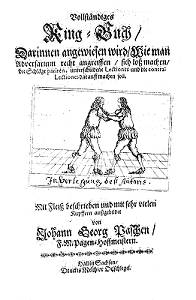
A complete English translation
by Eli Steenput
November 2000
Translator's notes
This is an interesting little 17th century wrestling manual by Passhen (who also
produced a fencieng text) with focus on unarmed defence, and surprisingly complete in the
types of techniques covered. It is also boringly repetitious and the explanations are not
extraordinarily clear. The clarity is not improved by a paragraph numbering scheme that
doesn't match the picture numbers, and the hard to read, fraktur-style typeface. I have
omitted the paragraph numbering as I found it more confusing than helpful. The original
has the pictures grouped, I have placed them with the relevant paragraphs.
The work is divided in a first part, an other part, and a third part,
for no obvious reasons.
Most techniques have an inwendig and auswendig variant, the illustrations
annoyingly show left and right versions for one variant, but don't show the other variant
at all. I have translated these terms as inwards and outwards, for lack of
better alternatives. Inwendig seems to mean mostly that the technique happens
between your or his arms, and auswendig, outside of the arms, sometimes auswendig
seems to mean from the center outwards, though, so the terms or at least my translation is
not very consistent.
I left the latin words like Adversarius (opponent) from the original.
This translation is based on the version included in "Chronik alter
Kampfkunste", Weinmann, Berlin, 1997 (isbn 3 87892 031 8). My notes are in square
brackets [like this].
This translation is dedicated to the virtue of generosity.
This translation was published in the Journal of Western Martial Arts
Vollstandiges
Ring-Buch
Wherein is shown how to correctly come to grips with Adversarium,
to get free from holds, to parry blows, different Lectiones and the contra-Lectiones
that apply to them.
Described with care and illustrated with a very many coppers
by
Johann Georg Passchen
F.M. Pagen-Hoffmeistern
The high-honorable [Hochwurdige, Durchlauchtigen, Hochgebornen]
sovereign and lord,
Herrn Augusten dem Andern
Hertogen zu Sachsen, Julich, Cleve und Berg
Landgrafen in Thuringen, Marggrafen zu Meissen, auch Oder und Nieder Lausis
Grafen zu der Marck, Ravensberg und Barbn
Herrn zum Ravenstein, etc [it says etc. in the original!]
Dom-Provsten zu Magdeburg
Seinem Enddigsten Fursten und Herrn
accept this from your most humble servant,
Johann Georg Pascha
1659 [this date is in a non-matching type and seems to be added later]
To the gentle reader
Wrestling ['Ringen'] is a useful exercitium, and well-known history shows that
it was practiced by our forefathers not only for fun, but also in earnest, because it not
only improves the condition of the whole body, but so also a weaker person can, by
knowledge of this science, and fully trained therein, defend himself against a stronger
one, and resist him. As high as it was esteemed by our forefathers, so little is it known
in our time, and these days everyone relies on their size and strength, yet they feel in
danger when confronted by a smaller man trained in wrestling. These circumstances have
prompted me to bring some things to light in this print and coppers. Do not hesitate,
lovers of wrestling, to willingly accept this little work by me, which I place in God's
care.
Ringen
First Part
First it is necessary to know, that the human arm can be divided in three parts, the
Strong, the Half-Strong, and the Weak, as shown on figure 1.
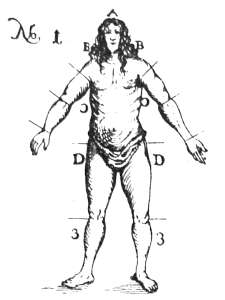
The head has two parts, the Strong and the Weak. On top of the head (A) is the Weak,
and below (B) the Strong.
The body and feet have three parts, the Strong, Half-Strong and Weak, marked C, D and E
in figure 1.
When you try to break free from a hold, you must usually apply the Half-Strong of your
arm to the Weak of your Adversarii.
When Adversarius grasps your right arm, you free it outwards, as in N° 2.
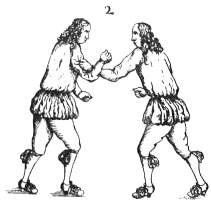
When Adversarius grasps your left arm, you free it outwards, as in N° 3.
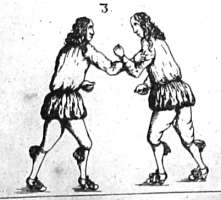
When Adversarius grasps your right arm, you free it inwards.
When Adversarius grasps your left arm, you free it inwards.
When Adversarius grasps your right arm, so strike Adversarium strongly on
his arm-joint as in N° 4.
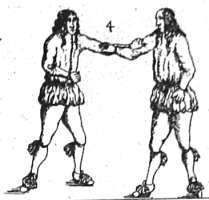
Do the same when Advers. grasps your left arm.
When Adversarius grasps with his right hand the strong of your left arm, grab
with both hands over his weak and push down as in N° 5.
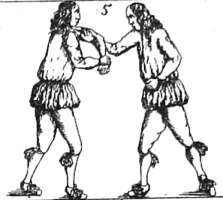
Do the same when he grasps with his left hand the strong of your right arm.
When Adversarius grasps both of your arms, free yourself outwards as in N° 6.
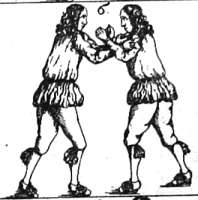
When Adversarius grasps both of your arms, free yourself inwards.
When Adversarius grasps both of your arms, strike him with both hands on his
elbows, as in N° 7.
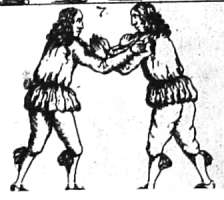
When you can get your fingers between those of Adversarii, so press his hands
back, then he must sink to his knee, which N° 8 shows, or turn his fingers outwards, so
will he sprain them.
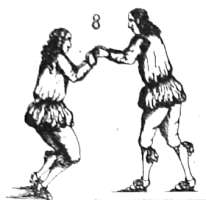
When Adversarius wants to throw a jar or some such at you, advance towards him
with your arms crosswise, covering your head, as in N° 9.
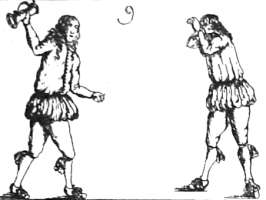
When Adversarius grasps you crosswise, you free yourself outwards, as in N° 10.
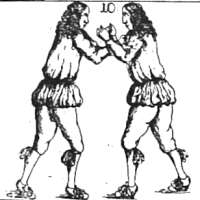
When Adversarius grasps you crosswise, you free yourself inwards.
When Adversarius grasps you with both hands in the strong of your arms, so place
your right hand on your right hip, and strike with your right elbow his hands away, as
shown in N° 11.
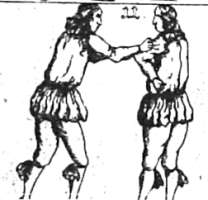
Or strike his hands away with your left elbow.
Or when Adversarius grasps you in this way, so strike with your right arm over
both his arms, so he must let go, as shown in N° 12.
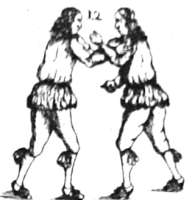
Or with your left arm over both his arms.
When Adversarius has taken your right hand at the weak, free yourself outwards,
as in N° 13.
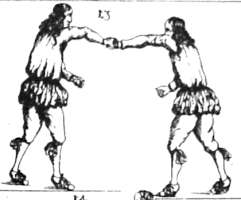
The same inwards.
When Adversarius has taken your left hand at the weak, free yourself outwards,
as in N° 14.
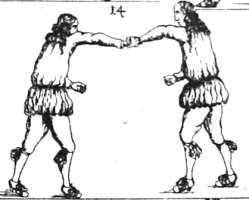
The same inwards.
When Adversarius has taken both your hands at the weak, so free yourself with
both hands outwards, as in N° 15.
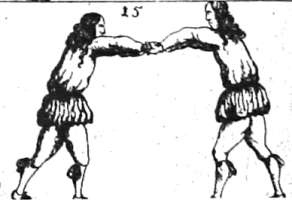
The same inwards.
Other Part
When Adversarius has taken hold of your right flank, so free yourself outwards,
as in N° 16.
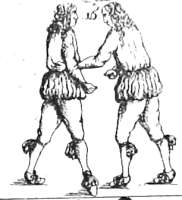
The same inwards.
When Adversarius has taken hold of your left flank, so free yourself outwards,
as in N° 17.
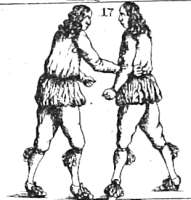
The same inwards.
When Adversarius has taken hold of both your sides with both hands, so free
yourself inwards with both hands, as in N° 18.
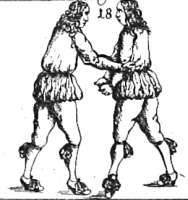
When Adversarius has taken hold of both your sides with both hands, so free
yourself outwards with your right hand [in this and some of the following, it seems that
the arm is used rather than the hand mentioned in the text] in Adversarii weak, as
in N° 19.
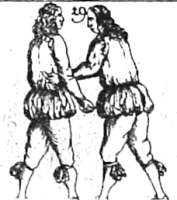
The same with your left hand outwards.
When Adversarius has taken hold of your left side with his right hand, so strike
him with your left hand on his right elbow, as in N° 20.
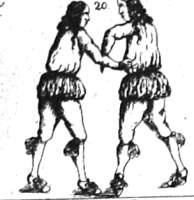
When Adversarius has taken hold of your right side with his left hand, so strike
him with your right hand on his left elbow.
When Adversarius has taken hold of both your sides with both hands, so strike
with both hands to both his elbows, as in N° 21.

When Adversarius has taken hold of your right side with his left hand, so strike
him with your right hand [arm, according to the figure] on his left elbow, as in N° 22.

You do the same for the other hand.
When Adversarius has taken hold of both your sides with both hands, so strike
with your right hand to his left elbow, as in N° 23.
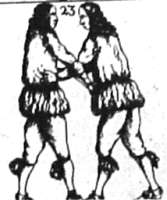
You can do the same with your left hand to his right elbow.
Or strike with both hands inwards to his weak, as in N° 24.
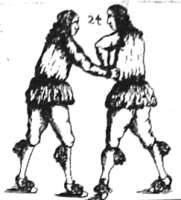
When Adversarius has grabbed your throat with his right hand, so free yourself
outwards with your right hand, as in N° 25. [in this and the following technique, the
inwards and outwards seem to have opposite meanings than up till now]
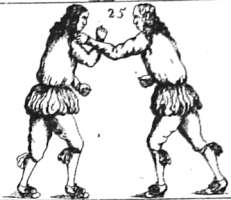
Or inwards with the right hand.
When Adversarius has grabbed your throat with his left hand, so free yourself
outwards with the left hand, as in N° 26.
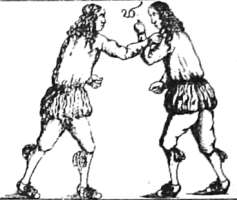
Or with the left hand inwards.
When Adversarius has grabbed your throat with both hands, so free yourself
outwards with both your hands, as in N° 27.
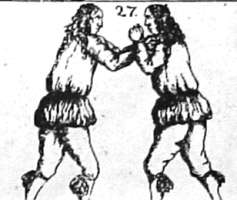
The same inwards.
When Adversarius has grabbed your throat with his right hand, so place your left
hand on your hip, and strike with your left elbow his right arm loose, as in N° 28.
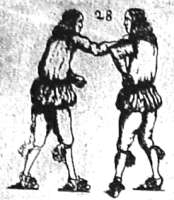
You can do the same with your right elbow, if he grabs your throat with the left hand.
When Adversarius has grabbed your sides with both hands, so bear down with both
your elbows between his arms on his weak, and so free yourself, as in N° 29.
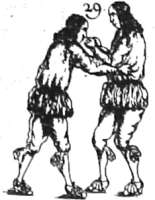
Make the Parade with the right arm high, as in N° 30.
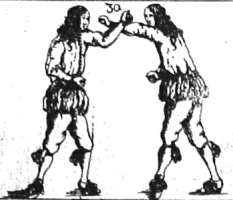
The same with the left arm high.
Make the Parade with the right arm low, as in N° 31.
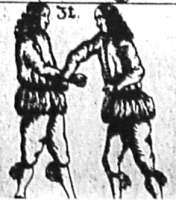
The same with the left arm low.
[Sensitive readers may want to skip the rest.
For the not-so-sensitive, this is where the good stuff starts.]
Strike with the edge of your flat hand to Advers. nose, as in N° 32, also the
same way to his mouth [Maul] or throat [Gurgel].
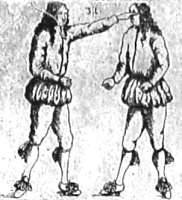
Pull Adversarium head back by the hair with your right hand [in the drawing this
seems to be the left hand], and strike him with your closed fist upwards on the chin, as
in N° 33.
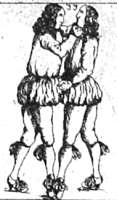
When Advers. has enclosed you with his arms [a bear hug from the front], push
both your thumbs in his mouth between his cheeks and teeth, and tear his mouth, as in N°
34 [the drawing shows this with one hand - try it on yourself to feel if it workks].

Strike Adversarium with your right elbow in the face, as in N° 35, so also to
the ribs.
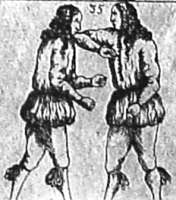
Or with your left elbow.
Third Part
When Adversarium is holding something in his fist, grab his hand with both your
hands, pull down strongly, and headbutt him in the face [at least that's what I think the
obscure phrase means - the goat bit him in the veins of the head?], as in N° 36.
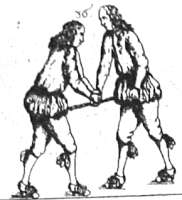
Grab Adversario with your left or right hand by the throat and strongly push it,
as in N° 37.
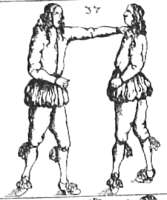
Kick Adversarium with your right foot to his right knee, breaking it, as shown
in N° 38.
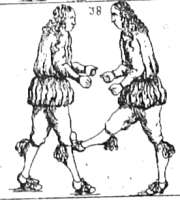
Or with your left foot to his left knee.
When Adversarius wants to break your knee in this way, so draw back your foot,
grab his foot with both hands, and throw him, as shown in N° 39.
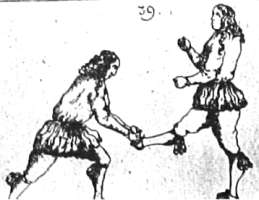
When Adversarius grabs your coat from the front, so free yourself with your
elbows, grab both his legs, place your head against his body, and throw him backwards, as
in N° 40.
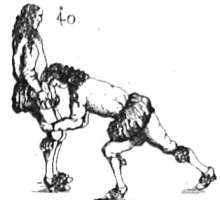
Take Advers. by his right hand with your right hand, twist it inwards, and with
your left hand strike his arm in two, as in N° 41.
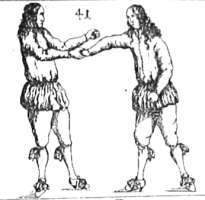
So also with the other hand.
When Adversarius thus breaks your right arm [I assume the author means
"wants to break your right arm"], free yourself by striking his face with your
right elbow, as in N° 42.
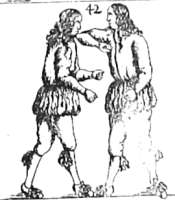
So also with the left elbow.
Grab with your right hand Adversarii right hand, pull it towards you, and break
his arm with your left hand, as shown in N° 43 [here the arm seems to be twisted in the
opposite direction, compared to the previous techniques, and the elbow is struck from
below].
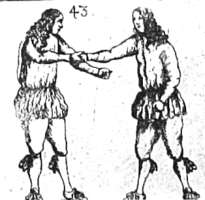
So also with the other hand.
The Contra, turn your arm and free it as N° 44 shows, or strike Adversario with
your elbow on the face.

Grip Adversarii right arm with both hands, bring the same on your right
shoulder, and break it as in N° 45a.
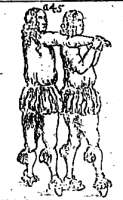
The Contra, turn the arm, grab his left foot with your left hand, and throw him
over your right leg, as in N° 45b. [a very similar counter is given in Flos
Duellatorum by Fiore Dei Liberi, 1410]
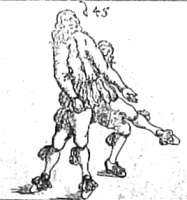
Grip Adversarii left arm with both hands, bring the same on your left shoulder,
and break it.
The Contra, as before.
Or turn turn the arm and place the knee on the back of Adversarii knee, and pull
him down on his back, as in N° 46 [the drawing doesn't show the knee part].

When Adversarius grasps you with both hands at the strong of your arms, break
the grip of his left hand outwards, and at the same time throw your right arm around his
body under his arm, jump with your right hip in front of his body, as in N° 47, and throw
him [looks like a o-goshi hip throw].
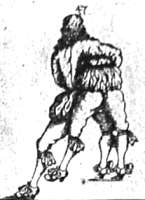
The same over your left hip.
Grab Adversarium inwards, and push him, as in N° 48.
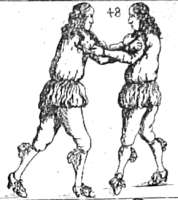
The Contra, place your feet and push back, as in N° 49.
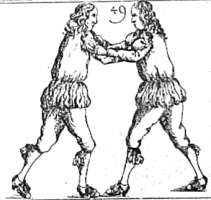
Place your head against Adversarii body, as in N° 50, and run him over.

The Contra, push his head down, and grab him by the back of his pants, so he
falls on his head, as in N° 51.
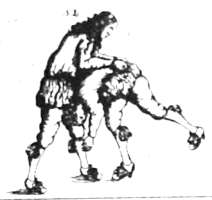
Or strike his face with your knee as in N° 52.
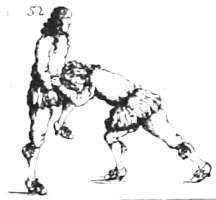
Insert your head between Adversarii legs, and throw him over you, as in N° 53.
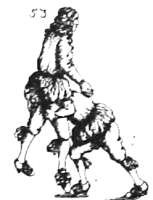
The Contra, grab the back of his pants, so he falls on his face, as shown in N°
51.
Place your head against Adversarii body, grab behind his knees with both hands,
as in N° 54, and throw him behind you.
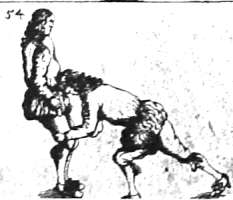
The Contra as in N° 52 [the print said 25, this was erased and corrected by
hand]. |

